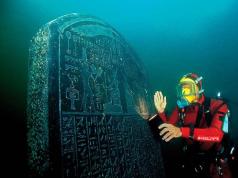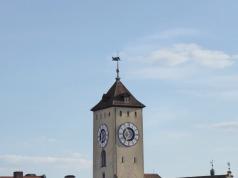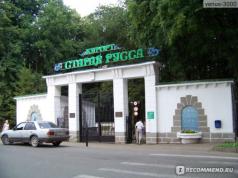
Heraklion is a city of legends, a sunken port city located 6.5 kilometers from the coastline. The city was founded around the eighth century BC and disappeared into the depths of the Mediterranean Sea in the eighth century AD.
Until the founding of Alexandria in 331 BC. the city knew glorious times as the main seaport at the mouth of the Nile, which met ships bound for Egypt

Its inhabitants, thanks to contacts with foreign merchants and sailors who often visited the city on their way to Egypt, were educated people. The main temple of the city was dedicated to the god Amon.
In the first century BC. there was a strong earthquake that leveled houses, sank ships in the harbor, killed most of the inhabitants of the city, forcing the rest to flee, leaving behind all valuable property.

For two millennia, the ruins of the city, hidden from prying eyes by sediments of silt and ten meters of water, lay 3 kilometers from the coast of Alexandria in the bay of Aboukir.
But last summer, French archaeologist Franck Gaudiot announced that he had unearthed the remains of a city he thought belonged to Heraklion: a black granite slab or stele with the word "Heraclion" written on it, the remains of ten ships in the former harbor, as well as thousands of others. items, including jewelry, coins, vases and personal items.

The inscription on the base of the stele certifies that this slab was to be erected in "Herakleion-Tronis (Herakleion-Thonis)". This is the first clear evidence that the discovered city is the hitherto semi-mythical Heraklion.

One of the first to be found was the great temple of Heraklion.
The remains of thick stone walls indicate the border of its territory. Next to the collapsed walls, archaeologists found three huge statues of pink granite, which were supposedly toppled during the earthquake. Two statues depict a hitherto unknown pharaoh and his wife. The third statue is Hapi, the Egyptian god of the Nile flood.

Bronze statue of Osiris
Inside the temple is a monumental pink granite tomb covered with hieroglyphs. Its upper part is still difficult to read, but a preliminary translation of the texts placed on the lower parts shows that this is undoubtedly the temple of Heraklion. A number of scholars, including Manfred Klauss of the University of Frankfurt, believe that the final deciphering of the inscriptions on the tomb will provide even more

Cleopatra II dressed as the goddess Isis
An even greater impression is made by a two-meter black granite stele - an almost complete copy of the stele found in 1899 in Nokratzh. This is the first case of duplication of stelae in Egyptology. The stele from Nokratj, now in the Egyptian Museum in Cairo, bears the text of a decree from Pharaoh Noctanebus I, founder of the 30th Dynasty, who ascended the throne in November 380 BC. This decree introduced a 10 percent tax on Greek artisans and goods in Nokratzh and Tonis, which was to be directed to the construction of a temple to the goddess Neith.

The text ends with the words: “And His Majesty said: “Let this be carved on a stele erected in Nokratzh, on the banks of the Canal of Anu.” The found stele is no different from the first one, with the exception of the last sentence, which says: “And His Majesty said:“ Let this be carved on the stele, installed at the entrance to the Greek Sea in Heraklion-Thonis.

A colossal statue of red granite (5.4 m) of the god Hapi, which adorned the temple of Heracleon. The flood god of the Nile, a symbol of abundance and fertility.

Among the finds are gold earrings, bracelets, hairpins, rings, combs, a beautiful glazed Greek goblet, an incense burner for aromatic substances, hundreds of coins. All of them have only a slightly scratched surface. And this is only the beginning - the main excavations (if this concept can be applied to archaeological work under water) are ahead.

Bronze statue of a pharaoh of the 26th dynasty
Divers and explorers have found 64 Egyptian ships built between the eighth and second centuries BC. Many of the ships may have been sunk as they were found perfectly preserved on the seabed. Researchers believe that this ship cemetery is the largest maritime collection of the ancient world.









Porto is the second largest city in Portugal, as well as an important economic, industrial and cultural center of the country. The city is located in the northwestern part of the Iberian Peninsula, 270 km north of Lisbon, at the mouth of the Douro River and just a few kilometers from the Atlantic Ocean. Porto is often referred to as the "northern capital" of Portugal.
Ancient times
The history of modern Porto dates back to ancient times, when the Iberian Peninsula was occupied by the Romans, and has more than two thousand years. In those days, the city was called Portus Kale and was a fairly large trading port of the empire.
After the collapse of the Roman Empire, the Suebi dominated Porto, and from 585 the Visigoths. In 711, during the Arab invasion of the Iberian Peninsula, Porto was one of the first to be captured by the Moors. In 868, the commander and vassal of the King of Asturias Alfonso III the Great Vimar Peres set off to reconquer the lands occupied by the Moors. After the liberation of the area between the Minho and Douro rivers (including the city of Porto), with the permission of Alfonso III Vimar Peres, he founded and headed the county of Condado de Portucale here, from which the name "Portugal" subsequently came.
Middle Ages
In 1387, the marriage of the King of Portugal, João I, and the daughter of the English Duke John of Gaunt, Philippa of Lancaster, took place in Porto. The Anglo-Portuguese Alliance, which is still active today, is the oldest military alliance in world history.
In the 14th and 15th centuries, Porto became one of the largest shipbuilding centers in Portugal. At the beginning of the 15th century, at the initiative of the Portuguese Infante Henry the Navigator (son of King John I), a series of expeditions were organized from Porto to the south along the West African coast, which, in fact, laid the foundations of the maritime and colonial power of Portugal, and also marked the beginning of the era of the “Great geographical discoveries.
new time
In 1809, Porto suffered heavily during the invasion of Portugal by Napoleon Bonaparte's troops, and already in 1820 it became one of the centers of the Portuguese Revolution, which led to the adoption of a liberal constitution in 1822 and subsequent civil wars between adherents of absolute and constitutional monarchies. The city played an important role in the 1910 revolution that abolished the monarchy, as well as in the 1974 revolution, which resulted in the final formation of democracy in Portugal.
In 1996, the historic center of Porto was inscribed on the UNESCO World Heritage List. Today, Porto is one of the most colorful cities in Europe, the architectural appearance of which so harmoniously combines various styles - Romanesque, Gothic, Renaissance, Baroque, Neoclassic and Art Nouveau.
The age of the port, according to scientists, is 4600 years. Cheops, also known as Khufu, reigned from 2580 to 2550 BC. The harbor was built 180 kilometers south of Suez, in the foothills of the desert mountains.
The port was found near a huge papyri archive, which is the oldest known to date. These papyri describe the process of building a port that was used by King Cheops to bring in the materials needed to build the Great Pyramid of Giza.
Because the port is located far from Giza, most likely it served for the supply of relatively light copper and minerals used for making tools. And the tools have already been used to build the pyramid.
According to the head of the excavations, Professor Pierre Tallet of the Sorbonne, the very fact of the existence of this harbor gives us an idea of the effectiveness of management and its (Cheops) ability to organize very complex logistics operations almost five thousand years ago.




Archaeologists, in particular, found 22 ship's anchors covered with limestone in the mooring area, which probably fell from ships, since no signs of wrecks were found. Several large vessels for storing various things were found next to the anchors, as well as pottery kilns. Near the pier, scientists found the remains of large stone structures 30 meters long and 8 to 12 meters wide.
Talle believes that these were the administrative centers that coordinated the operation of the port, and were also used to store materials and food for the miners working in the Sinai. Well, and as a kind of hotel for sailors.
Between two of these structures, archaeologists found a cache of 99 stone anchors, some of which are still with ropes. A significant number have inscriptions in red ink with the name of the vessel. This is really an impressive level of organization for that time.
In August, another archaeological sensation was voiced on television. An ancient Greek port was discovered at the mouth of the Don River near the farm of the Donskoy Azov region.
Let's run ahead. At the site of the alleged ancient port, research was carried out with the help of scuba divers for two weeks. What exactly they found and what conclusions archaeologists made remains a mystery.
random finds
Ships and barges sail in this place, raising a wave, which in turn brings interesting ceramics and ancient coins ashore. Studying random finds on the shore, archaeologists suggested that there could well be an ancient Greek port. Good location, the depth of the river allows ships with large displacement to pass.
After geophysical exploration, interesting deviations were found at the mouth of the river, indicating that there are fragments of previously unknown structures under water. That is why it was originally decided to explore the place with the help of scuba divers.
The result of the first studies
Divers arrived from Moscow to explore the bottom, and an interesting and time-consuming work began on collecting items from the bottom. Indeed, numerous ruins of buildings, ceramics and a Scythian cheek-piece, originally taken for a doorknob, were discovered.
More accurate research results are not yet known. Perhaps in order not to attract the attention of black archaeologists to an interesting find.
Hypothesis of archaeologists
The main argument in favor of the ancient Greek port is the navigability of this place. According to scientists, there was shallow water near Azak itself, which means that large ships could not approach the shore. That is, the ancient port served as a harbor for large ships, and from here, on small ships and boats, merchants delivered their goods already to Azak.
Interesting site materials







